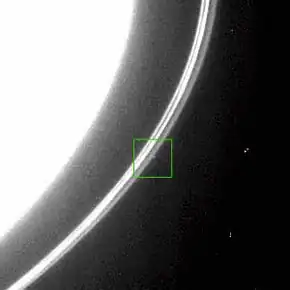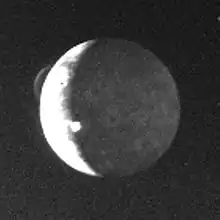In astronomy, a discovery image is typically a drawing, film base photograph, photographic plate, or digital image in which a celestial object or phenomenon was first found. This can include planets, dwarf planets, small Solar System bodies (asteroids, comets, etc.) or features found on or near those objects such as ring systems or large craters.
For example, a moon of Saturn, Phoebe, was the first satellite to be discovered photographically by William Henry Pickering on March 17, 1899 from photographic plates that had been taken starting on August 16, 1898 at Arequipa, Peru by DeLisle Stewart.[1][2][3][4][5]
Examples
 1978 image of Pluto and Charon; the discovery image of Charon
1978 image of Pluto and Charon; the discovery image of Charon Discovery image of Saturn's moon S/2004 S 3
Discovery image of Saturn's moon S/2004 S 3 Discovery image of active volcanism on Io
Discovery image of active volcanism on Io Discovery image of Pallene
Discovery image of Pallene Mariner crater on Mars, as viewed by Mariner 4
Mariner crater on Mars, as viewed by Mariner 4
See also
References
- ↑ Pickering, E. C.; Harvard College Observatory Bulletin, 49 (March 17, 1899)
- ↑ A New Satellite of Saturn, Astronomical Journal, Vol. 20, No. 458 (March 23, 1899), p. 13
- ↑ Pickering, E. C.; A New Satellite of Saturn, Astrophysical Journal, Vol. 9, No. 4 (April 10, 1899), pp. 274–276
- ↑ Pickering, E. C.; A New Satellite of Saturn, Astronomische Nachrichten, Vol. 149, No. 10 (April 29, 1899), pp. 189–192 (same as above)
- ↑ A Ninth Satellite to Saturn, The Observatory, Vol. 22, No. 278 (April 1899), pp. 158–159
Further reading
This article is issued from Wikipedia. The text is licensed under Creative Commons - Attribution - Sharealike. Additional terms may apply for the media files.